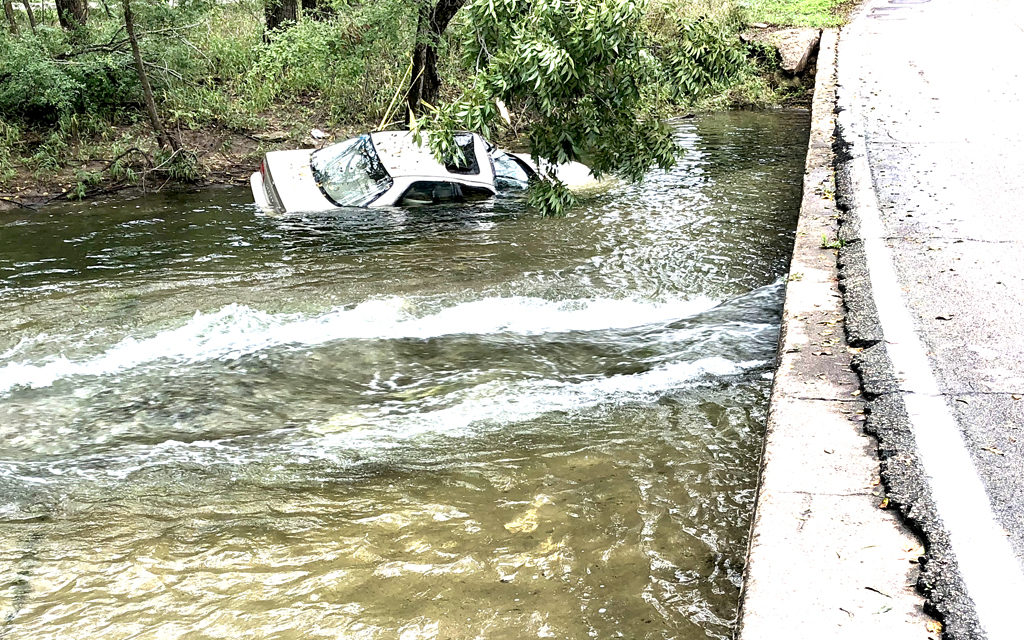THIS CAR WAS PROBABLY SWEPT OFF the road by the flooded Bull Creek during heavy October rains on the creek. Turn around; Don’t Drown! Rain Bombs in the Hill Country caused millions of dollars of damage, including a washed-out bridge over Lake LBJ at Kingsland. (Photo © John Jefferson, October 2018)
By John Jefferson
In case you’ve been living under a rock lately, we’ve had a little rise on the river.
Well, it was more than a little rise, and it happened on several Central Texas rivers, combining to create a colossal catastrophe. One newcomer to Texas said it was caused by urban sprawl. Small, Hill Country towns of Junction, Fredericksburg, Mason, Llano, and even Kingsland were hit by extraordinary storms. Several have less than 3,000 population. That’s hardly urban sprawl. What they have in common that affects major floods is that a river runs through them, or nearby, that feeds into the Colorado River. When heavy rains fall, that’s a lot of water for one stream to handle. Last week, it couldn’t.
An MIT meteorology professor spoke in Austin recently, according to the Austin American Statesman. He is quoted as saying the chance of a 15-inch rain storm hitting Central Texas was once thought to be about one in 1,000. Now, he says it’s about one in 50. Look at the number of storms in the past few years. They seem to be occurring more frequently over the Edwards Plateau. Why is that?
Well, some people say it’s Balcones’ fault. The Balcones Escarpment runs along the eastern edge of the Plateau and is the geologic uplift that gives us the Hill Country. That’s a good thing. It’s an enchanting land of hills, valleys, clear-running rivers and streams, countless springs, abundant wildlife, and breathtaking beauty. A beverage company launched an ad campaign in the ‘60s proclaiming their product was special because it was brewed with water from “the land of 1,100 springs.” Their scenic ads were intriguing. And effective.
But the Hill Country is said to be the crossroad where moist air from the Pacific meets the equally damp air off the Gulf from the south and east. As the air rises over the Balcones Fault, it cools and condenses, making it capable of dropping “rain bombs” on the Hill Country. That’s what the meteorologists and others call heavy storms like the one that dropped about ten inches of rain on Junction this month, the one that earlier flooded the Nueces and heavily damaged Camp Chalk Bluff, and the one that deluged the Blanco River in 2015, killing 12 people. They call the Hill Country “Flash Flood Alley.” Half of Texas’ 256 flash floods occurred in the Edwards Plateau, including six worldwide records.
My friend and occasional colleague, Steve Nelle, an esteemed wildlife biologist and natural resource authority, wrote an article in the January 2016 issue of Texas Wildlife magazine about Hill Country floods. In addition to the Escarpment, he points to the thin, rocky soils that don’t absorb heavy rain. Every gully or ravine becomes an aqueduct of runoff crashing downhill to the streams. Every creek becomes a swollen river, and rivers leave their banks, taking everything in their path to the lakes, including cars, boats, buildings and bodies.
Nelle says river bank vegetation may take years to recover, but eventually it will.
JJ




